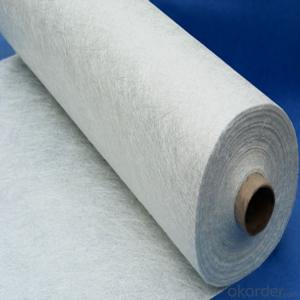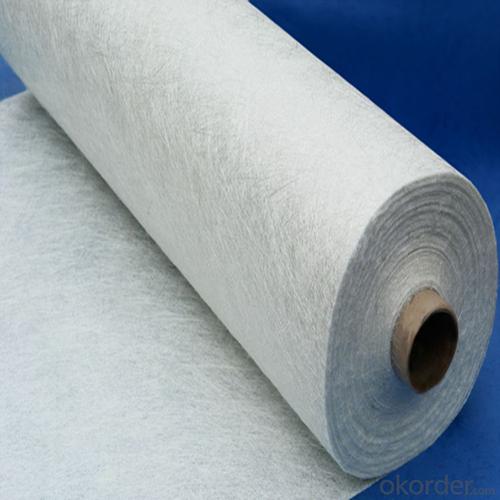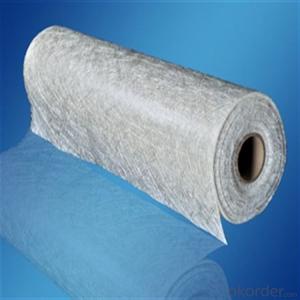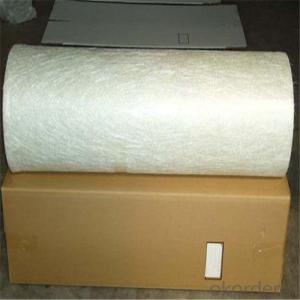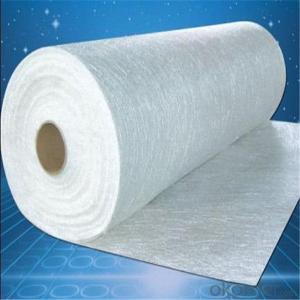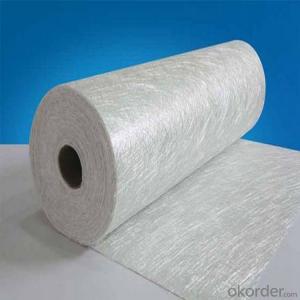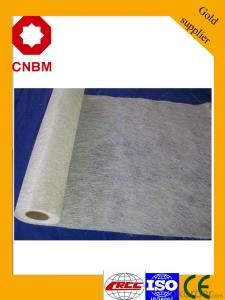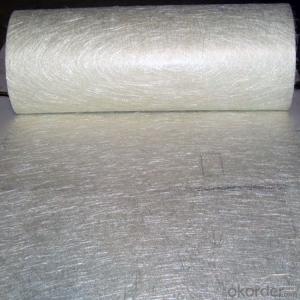Chopped Strand Fiberglass Mat 300 g/m2
- Loading Port:
- China main port
- Payment Terms:
- TT OR LC
- Min Order Qty:
- 1 kg
- Supply Capability:
- 5000 kg/month
OKorder Service Pledge
OKorder Financial Service
You Might Also Like
Product Description:

Surfacing Tissue mainly used in the surface layers of FRP products. It features even Fiber distribution, soft feel, level and smooth fiber surface, less glue content, quick resin soak and good pattern fitness. It can improve the product surface property on corrosion resistance, compressive strength, seepage resistance, and longer service life. It is also suitable for spraying; pattern pressing and other FRP pattern technology.
Surfacing Tissue mainly used in the surface layers of FRP products. It features even Fiber distribution, soft feel, level and smooth fiber surface, less glue content, quick resin soak and good pattern fitness. It can improve the product surface property on corrosion resistance, compressive strength, seepage resistance, and longer service life. It is also suitable for spraying; pattern pressing and other FRP pattern technology.
Product Features:
Fast breakdown in styrene
Fiber dispersed evenly
Low binder content
Superior acid corrosion resistance
Specifications:
Item | Over Density | Moisture Content | Chop Density | Polyester Yarn | Width |
(g/m2) | (%) | (g/m2) | (g/m2) | (mm) | |
EMK300 | 309.5 | ≤0.15 | 300 | 9.5 | 50-3300 |
EMK380 | 399 | 380 | 19 | ||
EMK450 | 459.5 | 450 | 9.5 | ||
EMK450 | 469 | 450 | 19 | ||
EMC0020 | 620.9 | 601.9 | 19 | ||
EMC0030 | 909.5 | 900 | 9.5 |
Product Packaging:
Each Surface Tissue is wound onto a paper tube which has an inside diameter of 76mm and the mat roll has a diameter of 330mm. The mat roll is wrapped up with plastic film,and then packed in a cardboard box or wrapped up with kraft paper. The rolls can be vertically or horizontally placed. For transportation, the rolls can be loaded into a cantainer directly or on pallets.
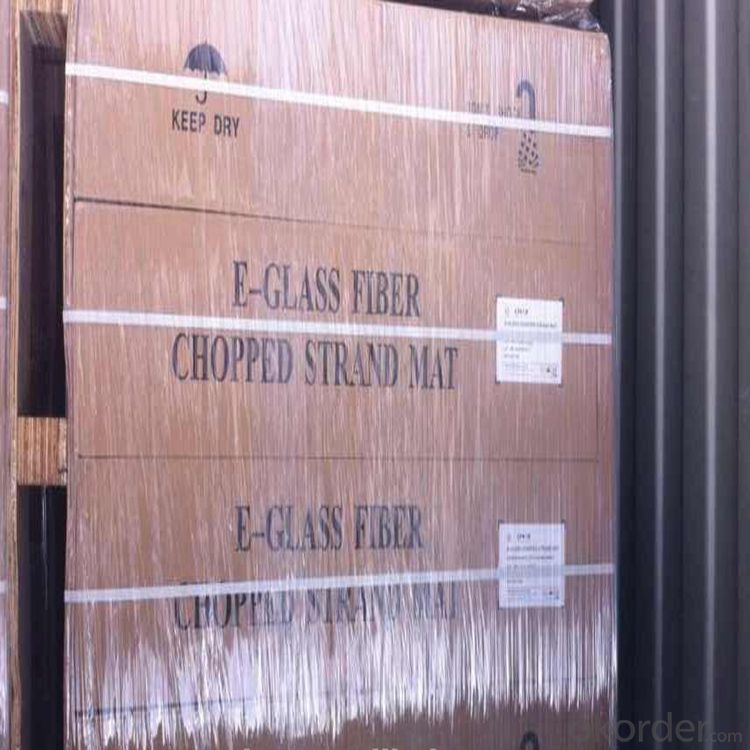
Product Storage:
Unless otherwise specified, Chopped Strand Mat should be stored in a dry, cool and rain-proof area. It is recommended that the room temperature and humidity should be always maintained at 15℃~35℃ and 50%~75% respectively.
Company Information
CNBM (China National Building Material) Group is the largest comprehensive building materials group in China that in integrate scientific research, manufacturing and logistics into one entity. The largest building materials and equipment specialists in China. Upon State Council approval, today CNBM owned more than 300 subordinate manufacturing factories and servicing companies. There are 6 fully owned public listed companies and 11 partially owned with substantial shares public listed companies. In many of these fields, CNBM is playing the leading role in the building industry in the country.

- Q: Does fiberglass chopped strand improve the chemical resistance of composite materials?
- Yes, fiberglass chopped strand can improve the chemical resistance of composite materials. The addition of fiberglass chopped strand to composite materials enhances their resistance to a wide range of chemicals, making them more durable and suitable for various applications in different industries.
- Q: What are the typical creep properties of chopped strand composites?
- The typical creep properties of chopped strand composites include a low creep rate, high creep resistance, and minimal creep deformation under sustained loading. These properties are a result of the reinforcement provided by the chopped strands, which enhance the composite's overall strength and stiffness, reducing the likelihood of creep occurring.
- Q: Is fiberglass chopped strand suitable for automotive interior components?
- Yes, fiberglass chopped strand is suitable for automotive interior components. Fiberglass is a versatile material that offers several advantages for automotive applications. It is lightweight, strong, and has excellent dimensional stability. These properties make it a suitable choice for various interior components such as door panels, dashboards, trim panels, and seat backs. Fiberglass chopped strand is commonly used in automotive interior components due to its superior mechanical properties. The chopped strands are mixed with a resin matrix to form a composite material that can be molded into various shapes. This allows for complex designs and customization options to meet specific automotive requirements. Additionally, fiberglass is resistant to heat, chemicals, and UV radiation, which are important considerations in the automotive industry. It can withstand high temperatures without compromising its structural integrity and is resistant to fading or discoloration caused by sunlight or chemical exposure. Furthermore, fiberglass chopped strand is an economical choice for automotive interior components. It offers a cost-effective solution without compromising on quality or performance. Its durability ensures long-lasting performance, reducing the need for frequent replacements and maintenance. In conclusion, fiberglass chopped strand is indeed suitable for automotive interior components. Its lightweight, strength, dimensional stability, resistance to heat and chemicals, and cost-effectiveness make it an ideal choice for various automotive applications.
- Q: Does the manufacturing process of fiberglass chopped strand involve any hazardous chemicals?
- Indeed, hazardous chemicals are utilized in the manufacturing process of fiberglass chopped strand. The procedure entails the melting of glass, which is subsequently extruded through exceedingly small apertures to form delicate fibers. Throughout this course, substances including boron, lead, arsenic, and formaldehyde might be employed. These particular chemicals possess potential risks to the well-being of laborers if appropriate safety precautions are disregarded. Hence, it is imperative for manufacturers to adhere to occupational health and safety regulations in order to safeguard both workers and the surroundings.
- Q: How is the density of fiberglass chopped strand determined?
- The density of fiberglass chopped strand is determined by measuring the weight of a known volume of the material. The chopped strand is weighed, and then its volume is determined using water displacement or by measuring its dimensions. The weight divided by the volume gives the density, which is typically expressed in grams per cubic centimeter (g/cm³) or kilograms per cubic meter (kg/m³).
- Q: Can fiberglass chopped strand be used in the production of building facades?
- Yes, fiberglass chopped strand can be used in the production of building facades. Fiberglass chopped strand is a type of reinforcement material that is commonly used in construction applications. It is made up of small strands of fiberglass that are randomly chopped into shorter lengths. These chopped strands can be mixed with other materials, such as resins or cement, to create a composite material that is strong and durable. In the production of building facades, fiberglass chopped strand can be incorporated into various components, such as panels, sheets, or cladding. It provides additional strength and reinforcement to the facade, making it resistant to impact, weathering, and other external factors. The use of fiberglass chopped strand in building facades can also enhance the overall fire resistance and thermal insulation properties of the structure. Furthermore, fiberglass chopped strand is a lightweight material, which makes it easier to handle and install during the construction process. It can be easily molded or formed into different shapes and sizes, allowing for flexibility in design. Additionally, fiberglass chopped strand has excellent corrosion resistance, ensuring that the building facade will remain intact and aesthetically pleasing for a long time. Overall, the use of fiberglass chopped strand in the production of building facades offers numerous benefits, including enhanced strength, durability, fire resistance, thermal insulation, and design flexibility. It is a cost-effective and reliable solution that can contribute to the longevity and performance of the building facade.
- Q: What are the typical quality control measures for fiberglass chopped strand composites?
- When it comes to fiberglass chopped strand composites, there are several typical quality control measures that are commonly employed to ensure the integrity and consistency of the final product. 1. Raw Material Inspection: The first step in quality control is to inspect the raw materials used in the production of fiberglass chopped strand composites. This includes checking the quality and specifications of the glass fibers, resins, and other additives to ensure they meet the required standards. 2. Process Control: Quality control measures are implemented throughout the manufacturing process to monitor and control various parameters such as temperature, pressure, and resin-to-fiber ratio. This helps to ensure that the manufacturing process is consistent and that the final product meets the required specifications. 3. Fiber Length and Distribution: The length and distribution of the chopped fibers play a crucial role in the mechanical properties of the composite. Quality control measures are employed to measure and monitor the fiber length and distribution to ensure they meet the specified requirements. 4. Composite Thickness and Density: The thickness and density of the fiberglass chopped strand composites are important factors that affect their performance. Quality control measures are implemented to measure and monitor the thickness and density of the composites to ensure they meet the required standards. 5. Mechanical Testing: Various mechanical tests are conducted on the fiberglass chopped strand composites to assess their strength, stiffness, and other mechanical properties. These tests include tensile strength, flexural strength, impact resistance, and fatigue testing. Quality control measures ensure that these tests are conducted accurately and consistently. 6. Visual Inspection: Visual inspection is an important quality control measure for fiberglass chopped strand composites. Trained inspectors visually examine the composites for any defects, such as voids, delamination, or surface imperfections, and ensure they meet the required cosmetic standards. 7. Dimensional Control: Quality control measures are implemented to measure and monitor the dimensions of the fiberglass chopped strand composites, such as length, width, and thickness, to ensure they are within the specified tolerances. 8. Packaging and Labeling: Quality control measures are also applied to the packaging and labeling of the fiberglass chopped strand composites. Inspections are conducted to ensure that the packaging is intact and protects the composites during transportation, and that the labeling accurately reflects the product specifications. Overall, these quality control measures help to ensure that fiberglass chopped strand composites meet the required standards for strength, durability, dimensional accuracy, and appearance. By implementing these measures, manufacturers can deliver high-quality products to their customers and maintain their reputation in the market.
- Q: What are the typical fatigue properties of chopped strand composites?
- Chopped strand composites can display varying fatigue properties depending on several factors, including the type of resin matrix, fiber orientation, fiber volume fraction, and processing conditions. In general, chopped strand composites demonstrate superior fatigue resistance compared to other composites. Typically, chopped strand composites are reinforced with randomly oriented short fibers embedded in the matrix. This randomness in fiber orientation helps to evenly distribute stresses throughout the material, resulting in improved fatigue resistance. Furthermore, the presence of these fibers aids in preventing crack propagation, thereby enhancing the fatigue life of the composite. To evaluate the fatigue properties of chopped strand composites, fatigue tests such as tension-tension fatigue or flexural fatigue tests are often conducted. These tests subject the material to cyclic loading conditions, simulating the repetitive stress experienced during its service life. Several factors can influence the fatigue behavior of chopped strand composites. For example, a higher fiber volume fraction generally leads to better fatigue resistance as it increases the composite's load-carrying capacity. Similarly, a higher resin toughness can improve fatigue properties by enhancing crack resistance. However, it is important to consider that chopped strand composites may experience reduced fatigue performance at high stress levels or in aggressive environments. This is because the short fibers may not effectively transfer stresses or resist chemical attack. Therefore, when assessing the fatigue properties of chopped strand composites, it is crucial to consider the specific application and operating conditions. In summary, chopped strand composites are recognized for their favorable fatigue resistance due to the random fiber orientation and presence of short fibers. However, the specific fatigue properties can vary based on the material composition and processing parameters utilized.
- Q: How is fiberglass chopped strand used in the packaging industry?
- Various applications in the packaging industry make fiberglass chopped strand widely used. One of its primary uses is as a reinforcement material, which is added to plastic packaging products to increase their strength and durability. During the manufacturing process, the chopped strands are typically mixed with the plastic resin to enhance the overall structural integrity of the packaging material. This reinforcement property is particularly beneficial for packaging items that need to withstand external pressures, like heavy loads or transportation. Furthermore, fiberglass chopped strand is utilized in the production of packaging molds. The strands are often incorporated into the mold material to prevent deformation or breaking during the production process, ensuring that the packaging molds maintain their shape and integrity. As a result, consistent and high-quality packaging products are produced. Another important application of fiberglass chopped strand in the packaging industry is for thermal insulation. By mixing the chopped strands with insulation materials like foam or polystyrene, their insulating properties are enhanced. This is especially useful for packaging products that require temperature control, such as perishable goods or pharmaceuticals. The fiberglass reinforcement creates a barrier that minimizes heat transfer, ensuring that the packaged items remain at the desired temperature for an extended period. In conclusion, fiberglass chopped strand plays a crucial role in the packaging industry by reinforcing plastic packaging products, strengthening packaging molds, and enhancing thermal insulation properties. Its versatility and ability to improve the strength and durability of packaging materials make it an essential component in the packaging manufacturing process.
- Q: How does the fatigue resistance of the chopped strand affect its performance?
- The performance of a chopped strand is significantly affected by its fatigue resistance. Fatigue resistance refers to a material's ability to withstand repeated loading and unloading cycles without experiencing a significant decrease in its mechanical properties or structural integrity. When chopped strand is used as a reinforcement material in various composite applications, its fatigue resistance directly impacts the durability and reliability of the final product. In dynamic or high-stress environments, the chopped strand must be able to endure repetitive stress without excessive deformation, degradation, or failure. A chopped strand with high fatigue resistance will exhibit enhanced performance compared to a material with lower fatigue resistance. It will be able to withstand a greater number of loading cycles before showing signs of mechanical deterioration, such as cracking, delamination, or loss of stiffness. The fatigue resistance of chopped strand is influenced by various factors, including the fibers used, the manufacturing process, and the composite matrix material. Fibers with higher tensile strength, like carbon or aramid fibers, generally have better fatigue resistance compared to weaker fibers such as glass. The manufacturing process, including the alignment and distribution of chopped strands within the composite, can also affect fatigue resistance. Properly aligned and evenly distributed strands can distribute the applied load more evenly, reducing stress concentrations and improving fatigue resistance. The composite matrix material also plays a role in fatigue resistance. The matrix should have good adhesion and compatibility with the chopped strand to ensure efficient load transfer and minimize the development of micro-cracks or failures at the fiber/matrix interface during cyclic loading. In conclusion, the fatigue resistance of chopped strand is crucial for determining its performance. Higher fatigue resistance leads to improved durability, longer service life, and overall better performance in dynamic or high-stress applications. Therefore, it is essential to select chopped strand materials with suitable fatigue resistance properties for specific applications to ensure reliable and long-lasting composite products.
Send your message to us
Chopped Strand Fiberglass Mat 300 g/m2
- Loading Port:
- China main port
- Payment Terms:
- TT OR LC
- Min Order Qty:
- 1 kg
- Supply Capability:
- 5000 kg/month
OKorder Service Pledge
OKorder Financial Service
Similar products
Hot products
Hot Searches
Related keywords

